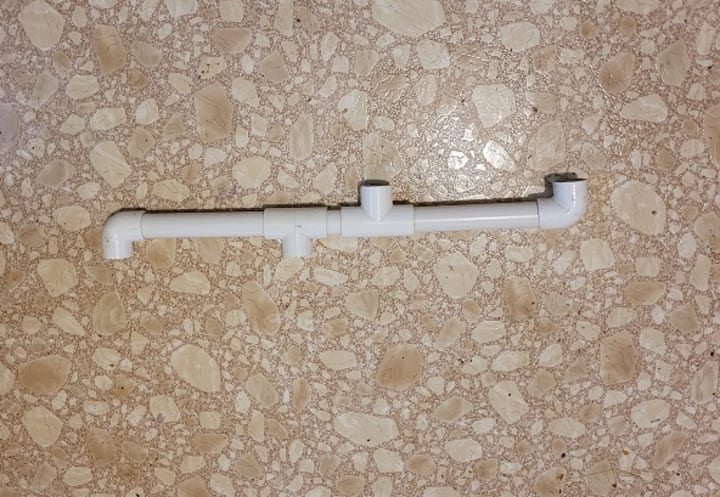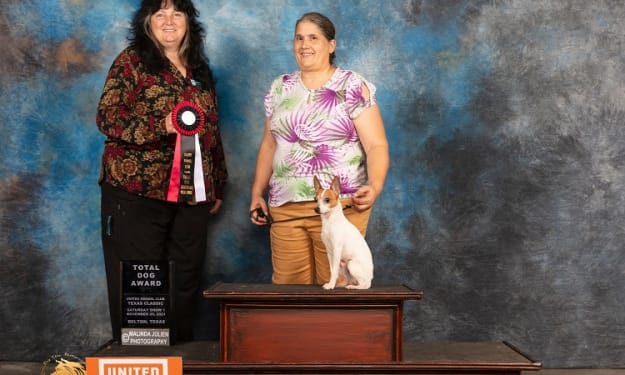Preparing for Obedience, Part 3
What on Earth is a front-finish frame?

Doing Things Differently
I learn something new with every dog I train for competition. Beau was the hardest dog for me, because he was the first one I ever put in competition--save for the Doberman Pinscher that preceded him by a good decade. I'd entered Carnelian into a match show many moons ago, but never pursued more training due to his horrible car sickness. Glitter, my late rough collie, was a joy who worked for all the cookies and praise I could dole out. Our trainer actually used her as a demo dog more than once! My sweet, distractable Badger has been a challenge from the word "go." He will continue to be a challenge until I cry "uncle."
And now . . . Widget.
I've never had to deal with a reactive dog before, so I'm learning some new things. I'm using more equipment than I've ever used before. I'm taking things slower and have learned that when he growls and huffs at a new item, it's time to back down a bit. And cookies . . . oh my gosh, the cookies . . . However, we are making a bit of progress.
Building the Frame
Building a front-finish frame requires one 10-foot length of schedule 40 PVC pipe, two elbows of the same dimension as the pipe, two T connectors of the same dimension, and something with which you can cut the pipe. If you want to get fancy, you can use PVC cleaning solvent and glue. You can even put caps on the ends of the pipe, if you want to do so. I might add caps in the future but chose not to do it until I decided how much value this frame would have for Widget.
Between having a homestead and training dogs, I always seem to have scraps of PVC pipe hanging around. I was actually able to scavenge the parts I needed from previous projects that have since been dismantled. Some of the pieces were already attached to each other, which is why I'm not showing the pieces all laid out before assembly in the picture below.
Based on Widget's measurements, we needed the front and side sections to be 18 inches long and roughly six inches wide. I figured that I would bump the side sections up to nine inches, given that he's still immature and his chest will widen. If I were cutting this frame from scratch, I would need the following pieces:
- 4 17.5-inch long
- 2 8-inch long
- 1 1.5-inch long
Assembling the pieces is simple. Start by connecting the two elbows with the 1.5-inch piece of PVC. The PVC should be inserted at the "end" of each T, with the center pieces facing in opposite directions. Make the fit as tight as you can get it--it doesn't have to be perfectly abutted, but it should be close to it.
Insert the 8-inch sections of pipe into the other end of the T, forming a straight line (8-inch pipe, T, 1.5-inch pipe, T, 8-inch pipe). Add the elbows to the end of the 8-inch sections. The open end of each elbow should face in the same direction as the open section of the corresponding T. Once again, tighten them down securely, so that the frame won't come apart while being moved. Finally, insert the four long pieces of PVC into the remaining openings, making them secure. If you feel inclined, you can trim the ends to match and add caps. I didn't feel inclined, as it would have required a 32-mile round trip to town. If the frame helps Widget, I might invest in them later, as well as in some colored tape to make the frame more visible to him when he comes in at greater speeds.

What Exactly Does the Front-Finish Frame Do?
The pet dog doesn't need to be bothered with close sits, unless the owner wants them. The competition obedience dog MUST sit close enough to the handler so that the handler can reach down and touch the dog without stretching. The dog must not be crowding or bumping the handler's leg. In addition, the dog must be directly in front of the handler or sitting with his shoulder next to the handler's left leg. Close, straight sits are a major part of scoring in obedience and Rally obedience trials.
The front-finish frame is a passive means of providing this distancing requirement to the dog. It provides both a visual cue and a spatial cue. The dog can see the "slot" into which he must go, directly in front of the handler or at the handler's side. In addition, the frame provides an area in which the dog will prefer to sit. Theoretically, at least, a dog will choose to sit on a flat surface, rather than an uneven or bumpy one. The typical dog will adjust his sit to be between the pipes, rather than sitting on one of them.
Why Use a Frame for Widget and Not Other Dogs?
The easy answer to that question is "I didn't see the need to build a frame when other dogs responded to traditional training." The more involved answer is, "Widget is reactive and things set him off that wouldn't bother another dog." With other dogs, I was able to use the wall or the back of the couch to provide a barrier while training close sits. Stand with the dog between you and the barrier and have the dog sit at your side. Rinse. Repeat. It's simple. Taught in a day and proofed with an occasional review.
A reactive dog, however, is an anxious dog. He is so busy reacting to his environment and to "scary" things that his brain can't absorb anything else. In Widget's case, he responds to those scary things by growling and snapping--given the choice between fight or flight, he thinks he prefers "fight." Being "trapped" between me and a wall while being expected to attempt a close sit would simply be a bad thing. The passive guidance provided by the frame allows him to make his own decisions. The frame will help build his confidence, not diminish it. Using a frame will take longer than the training described above, but it will be better for Widget.
How Did Widget React to the Frame?
To my amazement, Widget did not bark and fuss at the frame. Rather, he danced around it and allowed himself to be distracted by other dogs. It seems probable that his dancing was avoidance behavior. On the other hand, that in itself is a good sign because he remained calm and apparently happy instead of "warning" the frame away from him. We'll actually do some work with it this weekend. With luck, I'll be able to lure him (with adequate cookies) into each section of the frame.
Next up: What on Earth is a Toy Fox Terrier?
About the Creator
Kimberly J Egan
Welcome to LoupGarou/Conri Terriers and Not 1040 Farm! I try to write about what I know best: my dogs and my homestead. I currently have dogs, cats, dairy goats, quail, and chickens--and in 2025--rabbits! Come take a look into my life!






Comments
There are no comments for this story
Be the first to respond and start the conversation.